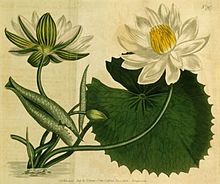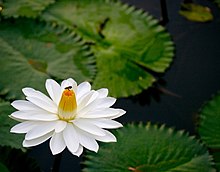Nymphaea lotus
| Nymphaea lotus | |
|---|---|
 |
|
 |
|
| Scientific classification | |
| Kingdom: | Plantae |
| (unranked): | Angiosperms |
| Order: | Nymphaeales |
| Family: | Nymphaeaceae |
| Genus: | Nymphaea |
| Species: | N. lotus |
| Binomial name | |
|
Nymphaea lotus L. |
|
| Subspecies | |
|
See text |
|
| Synonyms | |
|
Nymphaea dentata Schumach. |
|
See text
Nymphaea dentata Schumach.
Nymphaea lotus, the white Egyptian lotus,tiger lotus, white lotus or Egyptian white water-lily, is a flowering plant of the family Nymphaeaceae.
It grows in various parts of East Africa and Southeast Asia. Nymphaea lotus f. thermalis is a variety endemic to the thermal water of the Peţa River in the Bihor County, Transylvania, Romania, in Europe.
It was introduced into western cultivation in 1802 by Loddiges Nursery. Eduard Ortgies crossed Nymphaea lotus (N. dentata) with Nymphaea pubescens (N. rubra) to produce the first Nymphaea hybrid, illustrated in Flore des serres 8 t. 775, 776 under the name Nymphaea ortgiesiano-rubra. It is a popular ornamental aquatic plant in Venezuela.
This species of water lily has lily pads which float on the water, and blossoms which rise above the water.
It is a perennial, grows to 45 cm in height. The color of the flower is white and sometimes tinged with pink.
It is found in ponds, and prefers clear, warm, still and slightly acidic waters. It can be found in association with other aquatic plant species such as Utricularia stellaris
Nymphaea lotus is often used as a freshwater aquarium plant. In ornamental garden pools and in greenhouse culture it is grown for its flowers, which do not normally appear under aquarium conditions: aquarists prefer to trim the floating lily pads, and just maintain the underwater foliage. Strong light is required for deep reddish color in the "red" forms.
The tiger-like variegations appear under intense illumination.
Nymphaea lotus is often used as an aquarium plant
Nymphaea lotus showing variegations on leaves
In ancient times the Egyptian lotus was worshipped, especially in Egypt. It was considered a symbol of creation there. In Ancient Greece, it was a symbol of innocence and modesty.
...
Wikipedia
